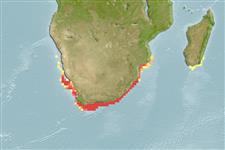>
Centrarchiformes (Basses) >
Latridae (Trumpeters)
Etymology: Chirodactylus: Greek, cheir = hand + Greek, daktylos = finger (Ref. 45335); for the long, unbranched lower pectoral fin rays (Ref. 120445).
More on author: Cuvier.
Environment: milieu / climate zone / depth range / distribution range
Ecologia
marinhas associadas(os) a recifes; intervalo de profundidade 0 - 240 m (Ref. 9492). Subtropical; 23°S - 36°S
Southeast Atlantic and Western Indian Ocean: Walvis Bay, Namibia around the Cape to Delagoa Bay, Mozambique.
Tamanho / Peso / Idade
Maturity: Lm ? range ? - ? cm
Max length : 40.0 cm TL macho/indeterminado; (Ref. 9492); common length : 25.0 cm TL macho/indeterminado; (Ref. 9492)
Descrição suscinta
Chaves de identificação | Morfologia | Morfometria
Espinhos dorsais (total) : 17 - 18; Raios dorsais (total) : 28 - 31; Espinhos anais: 3; Raios anais : 8 - 10.
Found in coastal waters from the shoreline to about 240 m depth, associated with reef areas (Ref. 9492) and rocky bottoms (Ref. 5319). Feeds on invertebrates (Ref. 27121).
Ciclo de vida ou comportamento de acasalamento
Maturidade | Reprodução | Desova | Ovos | Fecundidade | Larvas
Smith, M.M., 1986. Cheilodactylidae. p. 667-668. In M.M. Smith and P.C. Heemstra (eds.) Smiths' sea fishes. Springer-Verlag, Berlin. (Ref. 5319)
Status na Lista Vermelha da UICN (Ref. 130435: Version 2024-2)
Ameaça para os humanos
Harmless
Uso pelos humanos
Pescarias: pouco comercial; peixe esportivo: sim
Ferramentas
Relatórios especiais
Baixar XML
Fontes da internet
Estimates based on models
Preferred temperature (Ref.
123201): 12.2 - 24.5, mean 16.4 °C (based on 44 cells).
Índice de diversidade filogenética (Ref.
82804): PD
50 = 0.6250 [Uniqueness, from 0.5 = low to 2.0 = high].
Bayesian length-weight: a=0.01175 (0.00550 - 0.02508), b=3.04 (2.85 - 3.23), in cm total length, based on LWR estimates for this (Sub)family-body shape (Ref.
93245).
Nível Trófico (Ref.
69278): 3.5 ±0.37 se; based on food items.
Resiliência (Ref.
120179): médio(a), tempo mínimo de duplicação da população 1,4 - 4,4 anos (Preliminary K or Fecundity.).
Fishing Vulnerability (Ref.
59153): Low to moderate vulnerability (30 of 100).
Nutrients (Ref.
124155): Calcium = 25.7 [12.7, 51.9] mg/100g; Iron = 0.525 [0.321, 0.852] mg/100g; Protein = 19.7 [17.9, 21.6] %; Omega3 = 0.244 [0.154, 0.378] g/100g; Selenium = 20 [10, 35] μg/100g; VitaminA = 52.7 [19.1, 148.3] μg/100g; Zinc = 0.777 [0.537, 1.125] mg/100g (wet weight);
